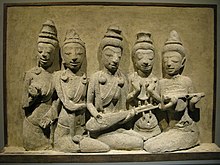Dvaravati
[7]: 267, 269 Its northern border met Chia-lo-she-fo, which was speculated to be either Kalasapura, situated along the coast of the Bay of Bengal somewhere between Tavoy and Rangoon,[10]: 108 or Canasapura in modern northeast Thailand.
[3] The Mon migrants as maritime traders might have brought the Dvaravati Civilization to the Menam Valley around 3000 BCE,[12]: 32 which continued to the presence of a "Proto-Dvaravati" period that spans the 4th to 5th centuries, and perhaps earlier.
[3] The center of the early Davaravati was speculated to be Ayodhyapura (present-day Si Thep) but the power was shifted to the lower basin in Lavo's Lavapura in the 10th and 11th centuries.
[7]: 283 [13]: 41 In the 11th century, Dvaravati's succeeded polity,[16] mentioned as Xiān (暹) by the Chinese and Đại Việt sources, was formed in the lower Menam Basin.
[3] A Khmer inscription dated 937 documents a line of princes of Canasapura started by a Bhagadatta and ended by a Sundaravarman and his sons Narapatisimhavarman and Mangalavarman.
[30][3] Archaeological, art historical, and epigraphic (inscriptions) evidence all indicate, however, that the main period of Dvaravati spanned the seventh to ninth centuries.
It might simply have been a loose gathering of chiefdoms rather than a centralised state, expanding from the coastal area of the upper peninsula to the riverine region of Chao Phraya River.
The three largest settlements appear to have been at Nakhon Pathom, Suphanburi, and Praak Sriracha, with additional centers at U Thong, Chansen, Khu Bua, Pong Tuk, Mueang Phra Rot, Lopburi, Si Mahosot, Kamphaeng Saen, Dong Lakhon, U-Taphao, Ban Khu Mueang, and Si Thep.
Dvaravati itself was heavily influenced by Indian culture, and played an important role in introducing Buddhism and particularly Buddhist art to the region.
Votive tablets have also been found, also moulds for tin amulets, pottery, terracotta trays, and a bronze chandelier, earrings, bells and cymbals.
